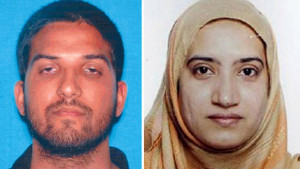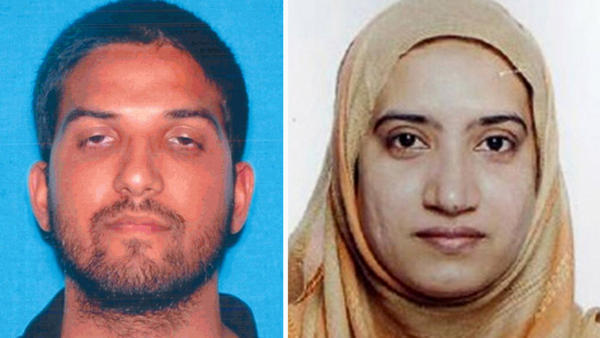
(Credit: LA Times)
Tashfeen Malik, the 29-year-old female shooter in the deadly San Bernardino rampage, was a onetime “modern girl” who became religious during college and then began posting extremist messages on Facebook after arriving in the U.S., a family member in Pakistan told the Los Angeles Times.
The family member, in Malik’s hometown of Karor Lal Esan who asked to not be identified, said Malik’s postings on Facebook were a source of concern for her family.
“After a couple of years in college, she started becoming religious. She started taking part in religious activities and also started asking women in the family and the locality to become good Muslims. She started taking part in religious activities of women in the area,” the family member told The Times.
“She used to talk to somebody in Arabic at night on the Internet. None of our family members in Pakistan know Arabic, so we do not know what she used to discuss,” the family member said. The family speaks Urdu and a dialect of Punjabi known as Saraiki.
Malik’s paternal aunt, Hafza Batool, told a local correspondent of the BBC that the family was in a state of shock. “She was so modern. I do not know what had happened to her. She brought a bad name to our family,” Batool said.
Malik pledged allegiance on Facebook to a leader of Islamic State just as Wednesday’s attack was getting underway.
The family member who spoke with The Times anonymously said Malik, who was born in Pakistan, moved with her family to Saudi Arabia when she was a child.
Malik traveled frequently to the Punjab region of Pakistan to visit family and then returned to study pharmacology at Bahauddin Zakariya University in the city of Multan in southern Punjab to study from 2007 to 2012, the family member said.
After attending the university in Pakistan, she returned to Saudi Arabia.
Malik met her future husband, Syed Rizwan Farook, online. The couple attacked a holiday gathering of Farook’s co-workers, killing 14 people and injuring 21 others in San Bernardino on Wednesday.
Farook, 28, was born in Chicago, and was the son of Pakistani immigrants — a truck driver and a clerk at Kaiser Permanente. He grew up in Riverside and attended La Sierra High School and studied at Cal State San Bernardino, earning a degree in environmental health. He then got a job as an inspector at the San Bernardino County Department of Public Health.
The two married last year in Islam’s holy city of Mecca in Saudi Arabia, according to Farook’s co-workers. Malik was granted a conditional green card last summer after a background check by the FBI and the Department of Homeland Security, and the couple held a walima, a celebration after the wedding, at the Islamic Center of Riverside for people who couldn’t attend the Saudi ceremony; a few hundred people attended, said Nizaam Ali, who worshiped with Farook at a San Bernardino mosque.
Ali said that he had met Malik on a few occasions, but that she wore a head scarf that obscured most of her face.
“If you asked me how she looked, I couldn’t tell you,” Ali said.
Malik and Farook had a baby girl in May.
Malik’s father owns a house in the Babar Colony neighborhood of Multan, where she attended the university, and she lived there during her studies.
The family was “not too social,” a neighbor told Pakistan’s Channel 24.
“The family would visit the house every three or four months, but they hardly have established links with the people in the area,” the neighbor said.
Dr. Nisar Hussain, one of Malik’s professors in the pharmacology department during her five years at the university, told The Times she was veiled when attending the college.
“She was religious, but a very normal person as well. She was a very hardworking and submissive student. She never created any problem in the class. She was an obedient girl. I cannot even imagine she could murder people,” he said in an interview.
Malik was a good student, and at one point, was first in her class, he said. “I don’t think she had any kind of mental illness. She was among the best students, always hardworking, never created problems.
“Yes, she was religious, but not an extremist. She never tried to influence the class in the name of religion, never,” he said.
women didn’t commingle.
“Tashfeen was an individual who kept to herself most of the time,” said Mohammad Abuershaid, an attorney representing the couple’s family. She was a soft-spoken housewife who stayed at home with the baby, the lawyer said, and the couple’s life was that of a “traditional” Muslim household.
Malik belonged to an educated, politically influential family from Karor Lal Esan in the Layyah district of Pakistan. Malik Ahmad Ali Aulakh, a cousin of Malik’s father, was once a provincial minister. Residents said the Aulakh family is known to have connections to militant Islam.
“The family has some extremist credentials,” said Zahid Gishkori, 32, a resident of the Layyah district in the area who knows the family well.
FBI director James B. Comey said Friday there is no indication that “these killers were part of an organized larger group or formed part of a cell. … There is no indication they were part of a network.”
Instead, the young couple fit a profile now distressingly familiar when looking at other recent acts of terrorism in the United States.
Malik and Farook were devout Muslims but not outwardly radical. They were members of a close-knit family with ties to the community. They built and stored crude pipe bombs in their home. And their attack apparently was inspired by, but not directed by, extremists abroad.
The couple thus had more in common with the Army psychiatrist who shot up a military facility at Ft. Hood, Texas, in 2009, and the North Caucasus brothers who set off homemade bombs at the Boston Marathon in 2013, than with the Belgian and French gunmen who killed 130 people last month in Paris.
In contrast with the Paris attacks, no evidence yet indicates that Farook and Malik were part of a larger conspiracy organized by Islamic State or another militant group, or were part of a bigger terrorist cell in California.
That helped them avoid detection before Wednesday’s massacre. Indeed, the absence of warning signs has become a hallmark of recent domestic plots, analysts said.
Investigators have learned that Farook had made contact — in some cases by phone and in others via social media — with people who came up tangentially in previous federal terrorism investigations. But he had not drawn any scrutiny.
Officials said that Malik had posted a comment swearing allegiance to Islamic State on a Facebook page — but only just before the couple stormed into a holiday party at the Inland Regional Center, guns blazing.
There was “nothing of such a significance” that it drew FBI attention before the attack, Comey said.
“The challenge the U.S. faces is that there are radical individuals who are being a lot more careful, and it makes them virtually impossible to detect,” said Seth Jones, a terrorism analyst with the Rand Corp., a Santa Monica-based think tank.
That is a change from the threat Americans faced after the Sept. 11, 2001, attacks, when Al Qaeda and its supporters repeatedly sought to bomb airliners or other U.S. targets, using operatives who were trained and directed by militants abroad.
With Al Qaeda now overshadowed by Islamic State, the threat inside the United States increasingly comes from self-radicalized individuals.
Their plots are less organized and possibly less deadly, but paradoxically are harder to stop, analysts say.
“There are no direct communications or orders that you can intercept to realize that there’s a plot going on,” said Bruce Hoffman, a terrorism expert at Georgetown University. “There’s an absence of red flags.”
Investigators may find that Farook and Malik left digital or other tracks that have not yet emerged.
After Maj. Nidal Malik Hasan killed 13 people and injured more than 30 at a military processing center at Ft. Hood on Nov. 5, 2009, for example, investigators found that a Joint Terrorism Task Force knew he had been in direct contact with Anwar Awlaki, an Al Qaeda leader in Yemen who was later killed in a U.S. drone strike.
And after Dzhokhar and Tamerlan Tsarnaev killed three people and wounded more than 260 at the Boston Marathon on April 15, 2013, the Russian government said it had warned the FBI two years earlier that Tamerlan and his mother were “adherents of radical Islam” and that he was preparing to join unspecified “bandit underground groups” in Dagestan and Chechnya.
The FBI failed to follow up on the warnings, a subsequent investigation showed.
Still, the pattern of Islamic extremists operating in the U.S. without outside direction is a clear change from the period after Sept. 11, 2001, when Al Qaeda and its supporters repeatedly sought to bomb airliners or other U.S. targets with operatives who were trained and directed by militants abroad.
Those included the incident in late 2001 when a British citizen tried to detonate explosives in his shoe on a flight to Miami; a foiled 2009 plot to bomb New York City subways by an Afghan American who had trained at Al Qaeda camps; and the 2010 attempted car bombing in New York’s Times Square by a Connecticut resident who had traveled to Pakistan for training.
Al Qaeda in the Arabian Peninsula, the network’s affiliate in Yemen, hatched two other failed plots — the 2009 attempt to down a Northwest Airlines flight over Detroit by a Nigerian man with a bomb in his underwear, and a 2010 attempt to explode bombs hidden in printer cartridges aboard two U.S.-bound cargo jets.
Even before Wednesday’s attack, the FBI had about 900 active investigations of suspected Islamic State sympathizers or supporters and other homegrown extremists. Authorities have arrested 71 people on charges related to the group since March 2014, including 56 this year.
The group’s social media, propaganda videos and direct appeals have exhorted followers to launch attacks in their own countries. In recent weeks, militants have bombed a Russian aircraft over Egypt, conducted bombings in Lebanon and Libya, and shot up restaurants and other sites in Paris.
Last fall, Islamic State released a video by a spokesman, Abu Muhammad Adnani, that called for revenge against countries that sent forces to Iraq and Syria to fight them, including Australia, France, Canada and the United States.
Michael C. Leiter, a former senior counterterrorism official in the George W. Bush and Obama administrations, said that signaled a greater danger in some ways because Islamic State wasn’t trying to send operatives into the United States.
“People ask, ‘Is it directed or is it inspired?’ I think that’s entirely the wrong rubric because their direction is to inspire,” Leiter said. “They are not looking to direct attacks at all.”
Special correspondent Sahi reported from Islamabad, and Times staff writers Cloud and Bennett from Washington.
Contributing to this report were Times staff writers Soumya Karlamangla, Paloma Esquivel, Laura J. Nelson, Harriet Ryan, Dexter Thomas, Matt Hamilton, W.J. Hennigan, Peter Jamison, Jack Dolan, Richard Winton, Richard A. Serrano, Joel Rubin, Joseph Serna, Veronica Rocha, Thomas Curwen, Corina Knoll, Marisa Gerber, Ruben Vives, Hailey Branson-Potts, Sarah Parvini, Kate Mather, Taylor Goldenstein, Anh Do, Lauren Raab, Christine Mai-Duc, Stephen Ceasar, Cindy Chang, Garrett Therolf, Paresh Dave, Phil Willon and Rong-Gong Lin II.

